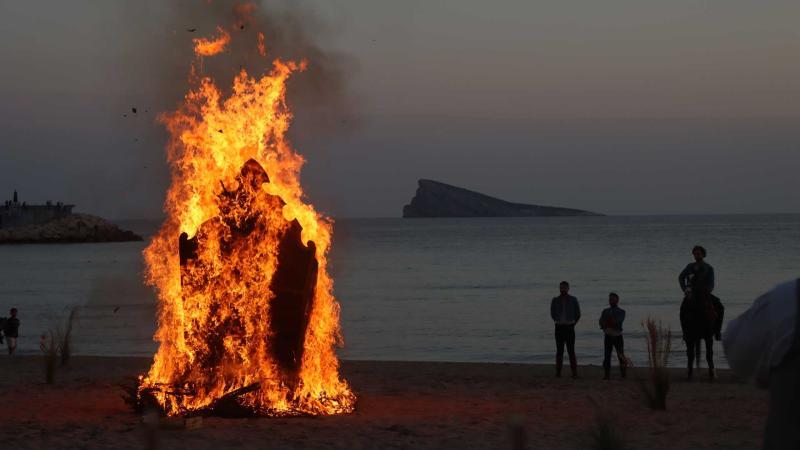

The Mare de Déu rises again from the ashes in the recreation of the Hallazgo
- The Benidorm festival-goers show their solidarity with those affected by the DANA through the mailbox installed next to the patron saint
- Juan Antonio Espinosa highlights in his sermon that “the Virgin favored Benidorm because she was preparing her arrival”
As always, the Festes Majors Patronals de Benidorm experienced one of the most intense and emotional days of this festive cycle yesterday Saturday. This day was when the locals remembered the days in mid-March 1740 when the image of the one who is now their patron saint, the Mare de Déu del Sofratge, arrived in the town.
He did it on board a boat that was sailing without a crew, adrift, and that was towed to the coast by three sailors from Benidorm. The Staging of the Finding, declared a Festival of Tourist Interest of the Valencian Community, brought together several hundred people on the Poniente sand to witness the event live, which has been performed every year since 1971 by the Associació Cultural y Recreativa La Barqueta. Before starting, however, a respectful minute of silence was observed for the victims of the DANA in Valencia and for Jaume Climent, a member of the ACR La Barqueta, who died less than a year ago.
This year, there have also been some new features, such as a new set for this event, funded by the Department of Culture and Festivals, as well as technical improvements in the recording that narrates the historical events. The set, specifically, is a mural, 35 metres wide by three metres high, which recreates the seaside town that was Benidorm at the time when those events occurred and which served to cover the entire perimeter wall of the Elche Park next to which the performance takes place. Its design was the work of local painter and member of La Barqueta, Miguel Ribes Sogorb.
The queens of the Fiestas, Valentina Almodóbar and Laia Zamora; the presidents of the Comissió de Festes and the Associació de Penyes, María Dolores Cano and Jaume Cortés; and a prominent representation of the Municipal Corporation and other authorities presided over the event that was witnessed by thousands of people. After the representation, which revived all the events that occurred almost three centuries ago and that were found by the historian Pere Maria Orts i Bosch in some files kept in the General Archive of Simancas, and after the rescue of the image of the patron saint from the flames, the procession left the Poniente arena to head towards the Elche Park, from where the Pilgrimage set off in the direction of the church of San Jaime and Santa Ana.
Hundreds of Benidorm residents, residents of other towns and tourists participated or applauded this parade along the entire route. And those who took part did so carrying colourful bouquets or baskets of flowers as a sign of devotion to the patron saint, to whom they blew kisses, asked for protection or before whom they shed tears of emotion or sadness in memory of loved ones.
But there was also time for solidarity. Benidorm, which has always been a town of solidarity, demonstrated it again yesterday. The festival-goers, the organisations, the clubs… deposited their help in the form of donations for those affected by the DANA in Valencia in the mailbox installed next to the image of the patron saint. A catastrophe that was very present in the interventions of all those who went up to the stage.
Among the most emotional moments was the moment when the eldest and youngest ladies of the Festes Majors Patronals and this year's queens handed over their bouquets to the Mare de Déu, as well as when Laia Zamora recited the traditional verse to the patron saint written by her mother, Rosana Picó, and Valentina Almodóbar dedicated a few words to the people of Benidorm.
The eldest queen remembered those affected and deceased by Dana and asked the Virgin for her protection. She also thanked her court of honour and referred to the Benidorm women “great-grandmothers, grandmothers and mothers, who have maintained our traditions”.
The queens, by the way, for the events yesterday evening wore skirts made from the same fabric that the first queens of the festivities wore 52 years ago.
The highlight of the speeches was the opening speech given by Juan Antonio Espinosa. Firstly, he expressed his condolences for those affected by the DANA “and his eternal gratitude to those who have helped”. “I pray for the souls of all those who have died. We will rise up and give an example of solidarity and hope” he added.
Espinosa stressed that it was “a great emotion to be here at the door of my church and in front of my virgin” and dedicated the speech to the chambermaids of the Mare de Deu and those who are no longer with us. And to my mother, a chambermaid like them.” He also stated that the virgin has “favoured” the city geographically because “she was preparing her arrival.” In his speech he spoke of the almadraba, musical and hospital tradition and had time to dedicate a few words to his penya, La Serp.
After the Official Proclamation, the president of the Festival Committee, María Dolores Cano, also dedicated a few words to her mayors, queens and ladies-in-waiting, members of the association, authorities and her own family, before giving way to the mayor of Benidorm, Toni Pérez, who put the finishing touch to the evening at around 11 p.m.
The mayor stressed that “one more evening we celebrate the event that best sums up what this town feels for its patron saint” and added that “if she were not here, there would be nothing to proclaim”. Pérez asserted that Benidorm is a town “that unwittingly went out to look for her. And she stayed with us”. “A town that has had and welcomed many cultures. We are hospitable, we never look where they come from”, no one added. The mayor ended by recalling that “in recent years we have experienced this event with more pain than joy” and “we feel with dignity and respect all the pain that the catastrophe in Valencia has caused us”.
The playing of the official anthems of Benidorm and the Valencian Community and the firing of fireworks put the finishing touch to the official programme for Saturday, although the party continued with concerts, atmosphere in the clubs and lots of people in the city.
Today Sunday, Benidorm celebrates the big day dedicated to the Mare de Déu del Sofratge, a day also full of events and which will have the mass, the mascletà, the procession this afternoon and the singing of les Copletes as its central moments.
First for the latest UK & Spanish news on the hour every hour!

Latest Music Video's
Spain's More Music Variety










